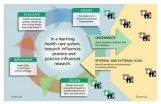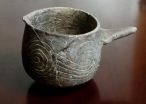(Press-News.org) Montreal, August 7, 2012 – Although it may not seem like much, the small wooden figurine Grandma brought back from the Holy Land has been blessed. She gives the souvenir to her grandchildren knowing she has done her job: deliver God into their lives.
A recent study led by Hillary Kaell, an associate professor in the Department of Religion at Concordia University, and published in the Journal of Material Culture looks at why and to whom people give souvenir gifts – an area of study that little is known about. For her research, she chose to focus on Christian American women, between the ages of 55 and 75, who travel to the Holy Land and who make souvenir purchasing an important part of their pilgrimage.
"Crucial in this endeavor is how pilgrims negotiate the fluid line between commodity and religious object," says Kaell, who mentions that according to the Israeli Census Bureau, more than 60,000 Canadians travel to Israel and the Palestinian Authority each year―most of whom are Christian pilgrims. "They imbue commercial souvenirs with divine presence therefore creating powerful tools for 'softly' asserting religion in their families' lives. Giving these souvenirs becomes another way to bolster faith."
Kaell based her study on ethnographic research conducted on the road in the Holy Land and then at pilgrims' homes after they had returned. Conversation interviews were held with 99 pilgrims and 34 industry professionals, the majority of the interviews consisting of pre and post trip conversations with pilgrims from five groups (three evangelical and two Catholic), as well as participant observation with two of these groups in the Holy Land.
What she found was that the gifts the women bought in the Holy Land were classified into two major groups: undirected ones for acquaintances and directed ones for family, especially children. These women expressed how they felt responsible for perpetuating their faith in the family – driving many of their religious behaviours, such as praying for their children, organizing baptisms and taking grandchildren to church.
The purchasing of the souvenirs in the Holy Land becomes an extension of this behaviour. By giving the gifts the women hope to spark an interest in religion. If the children are reticent to accept religious gifts, the gifts are delivered as souvenirs. The women believe that once accepted and displayed the Holy Land gift can open a way to a conversation with God, which fulfills the pilgrim's desire to pass faith down to the next generation.
"These women are very capable of harnessing the ability to portray the gifts as souvenirs sometimes and religious gifts other times," says Kaell. "A souvenir as a divine-presence filled gift can circumvent the problem of having a religious gift rejected—whether the child understands the true significance of the gift or not. The key is, a very important reason for their pilgrimage has been fulfilled."
###Research, continued: This study is a component of a larger book project that will be published with New York University Press.
Related links:
Of gifts and grandchildren: American Holy Land souvenirs: http://mcu.sagepub.com/content/17/2/133.abstract
Concordia University's Department of Religion: http://religion.concordia.ca/
Keeping the faith through souvenirs
Concordia study uncovers the real meaning of Grandma's gift buying in the Holy Land
2012-08-07
ELSE PRESS RELEASES FROM THIS DATE:
Method to prevent rejection of disease-fighting proteins described in Human Gene Therapy journal
2012-08-07
New Rochelle, NY, August 7, 2012—The body's natural reaction to reject replacement proteins represents a major obstacle to the successful use of gene therapy to cure a range of life-threatening diseases. A novel method that uses the body's own immune cells to induce tolerance to a specific protein was shown to suppress the rejection response, as described in an article in Human Gene Therapy, a peer-reviewed journal from Mary Ann Liebert, Inc.
(http://www.liebertpub.com). The article is available free online at the Human Gene Therapy (http://www.liebertpub.com/hum) website.
"A ...
Composite nanofibers developed by Penn scientists next chapter in orthopaedic biomaterials
2012-08-07
PHILADELPHIA – Bioengineered replacements for tendons, ligaments, the meniscus of the knee, and other tissues require re-creation of the exquisite architecture of these tissues in three dimensions. These fibrous, collagen-based tissues located throughout the body have an ordered structure that gives them their robust ability to bear extreme mechanical loading.
Many labs have been designing treatments for ACL and meniscus tears of the knee, rotator cuff injuries, and Achilles tendon ruptures for patients ranging from the weekend warrior to the elite Olympian. One popular ...
California's hydroelectricity production is vulnerable to climate change
2012-08-07
RIVERSIDE, Calif. — California's hydropower is vulnerable to climate change, a University of California, Riverside scientist has advised policymakers in "Our Changing Climate," a report released July 31 by the California Natural Resources Agency and the California Energy Commission (CEC).
"Climate change is expected to affect the quantity and timing of water flow in the state," explained Kaveh Madani, a former postdoctoral research scholar in UC Riverside's Water Science and Policy Center (WSPC), who led a research project on climate change effects on hydropower production, ...
Annals of Internal Medicine tip sheet for Aug. 7, 2012 issue
2012-08-07
1. Tuning into Contextual Clues May Help Doctors Improve Antibiotic Prescribing Habits
Appropriate use of antibiotics can improve patient outcomes and reduce risk for antibiotic resistance. Febrile respiratory illnesses, or FRI, often present with vague, cold-like symptoms, making it difficult to discern whether the illness is viral or bacterial. Since there are few bedside clues that reliably distinguish viral from bacterial, physicians rely on contextual factors to aid treatment decisions. Contextual factors include epidemiology (for example, flu pandemic period) and ...
Fainting: All in the family?
2012-08-07
MINNEAPOLIS – Fainting has a strong genetic predisposition, according to new research published in the August 7, 2012, print issue of Neurology®, the medical journal of the American Academy of Neurology. Fainting, also called vasovagal syncope, is a brief loss of consciousness when your body reacts to certain triggers, such as emotional distress or the sight of blood.
"The question of whether fainting is caused by genetic factors, environmental factors or a mixture of both has been the subject of debate," said study author Samuel F. Berkovic, MD, FRS, with the University ...
A 'learning health system' moves from idea to action
2012-08-07
In the United States, clinicians are struggling to provide better and more affordable health care to more people—while keeping up with new scientific developments. The idea of a "learning health system" is one proposed solution for rapidly applying the best available scientific evidence in real-time clinical practice. In the August 7 Annals of Internal Medicine, a Group Health Cooperative team describes the experience of turning this intriguing concept into action.
"In a learning health system, evidence and practice come together in a virtuous cycle, influencing each ...
Researchers peek at the early evolution of sex chromosomes
2012-08-07
CHAMPAIGN, Ill. — Two new studies offer insight into sex chromosome evolution by focusing on papaya, a multimillion dollar crop plant with a sexual problem (as far as growers are concerned) and a complicated past. The findings are described in two papers in the Proceedings of the National Academy of Sciences.
The research reveals that the papaya sex chromosomes have undergone dramatic changes in their short evolutionary histories (they are about 7 million years old; by comparison, human sex chromosomes began their evolution more than 167 million years ago). One of the ...
Researchers find evidence of ritual use of 'black drink' at Cahokia
2012-08-07
CHAMPAIGN, Ill. — People living 700 to 900 years ago in Cahokia, a massive settlement near the confluence of the Missouri and Mississippi Rivers, ritually used a caffeinated brew made from the leaves of a holly tree that grew hundreds of miles away, researchers report.
The discovery – made by analyzing plant residues in pottery beakers from Cahokia and its surroundings – is the earliest known use of this "black drink" in North America. It pushes back the date by at least 500 years, and adds to the evidence that a broad cultural and trade network thrived in the Midwest ...
Generic language helps fuel stereotypes, NYU, Princeton researchers find
2012-08-07
Hearing generic language to describe a category of people, such as "boys have short hair," can lead children to endorse a range of other stereotypes about the category, a study by researchers at New York University and Princeton University has found. Their research, which appears in the Proceedings of the National Academy of Sciences (PNAS), also points to more effective methods to reduce stereotyping and prejudice.
The study focused on "social essentialism," or the belief that certain social categories, such as race or gender, mark fundamentally distinct kinds of people. ...
Gladstone scientists discover that epilepsy drug reverses memory loss in animal model of AD
2012-08-07
SAN FRANCISCO, CA—August 6, 2012— Scientists at the Gladstone Institutes have discovered that an FDA-approved anti-epileptic drug reverses memory loss and alleviates other Alzheimer's-related impairments in an animal model of the disease.
Scientists in the laboratory of Lennart Mucke, MD, who directs neurological research at Gladstone, conducted the research on mice genetically modified to simulate key aspects of Alzheimer's disease. In the study, they show how levetiracetam—a drug commonly prescribed for patients who suffer from epilepsy—suppresses abnormal brain activity ...
LAST 30 PRESS RELEASES:
Decoupling the HOR enhancement on PtRu: Dynamically matching interfacial water to reaction coordinates
Sulfur isn’t poisonous when it synergistically acts with phosphine in olefins hydroformylation
URI researchers uncover molecular mechanisms behind speciation in corals
Chitin based carbon aerogel offers a cleaner way to store thermal energy
Tracing hidden sources of nitrate pollution in rapidly changing rural urban landscapes
Viruses on plastic pollution may quietly accelerate the spread of antibiotic resistance
Three UH Rainbow Babies & Children’s faculty elected to prestigious American Pediatric Society
Tunnel resilience models unveiled to aid post-earthquake recovery
Satellite communication systems: the future of 5G/6G connectivity
Space computing power networks: a new frontier for satellite technologies
Experiments advance potential of protein that makes hydrogen sulfide as a therapeutic target for Alzheimer’s disease
Examining private equity’s role in fertility care
Current Molecular Pharmacology achieves a landmark: real-time CiteScore advances to 7.2
Skeletal muscle epigenetic clocks developed using postmortem tissue from an Asian population
Estimating unemployment rates with social media data
Climate policies can backfire by eroding “green” values, study finds
Too much screen time too soon? A*STAR study links infant screen exposure to brain changes and teen anxiety
Global psychiatry mourns Professor Dan Stein, visionary who transformed mental health science across Africa and beyond
KIST develops eco-friendly palladium recovery technology to safeguard resource security
Statins significantly reduce mortality risk for adults with diabetes, regardless of cardiovascular risk
Brain immune cells may drive more damage in females than males with Alzheimer’s
Evidence-based recommendations empower clinicians to manage epilepsy in pregnancy
Fungus turns bark beetles’ defenses against them
There are new antivirals being tested for herpesviruses. Scientists now know how they work
CDI scientist, colleagues author review of global burden of fungus Candida auris
How does stroke influence speech comprehension?
B cells transiently unlock their plasticity, risking lymphoma development
Advanced AI dodel predicts spoken language outcomes in deaf children after cochlear implants
Multimodal imaging-based cerebral blood flow prediction model development in simulated microgravity
Accelerated streaming subgraph matching framework is faster, more robust, and scalable
[Press-News.org] Keeping the faith through souvenirsConcordia study uncovers the real meaning of Grandma's gift buying in the Holy Land





